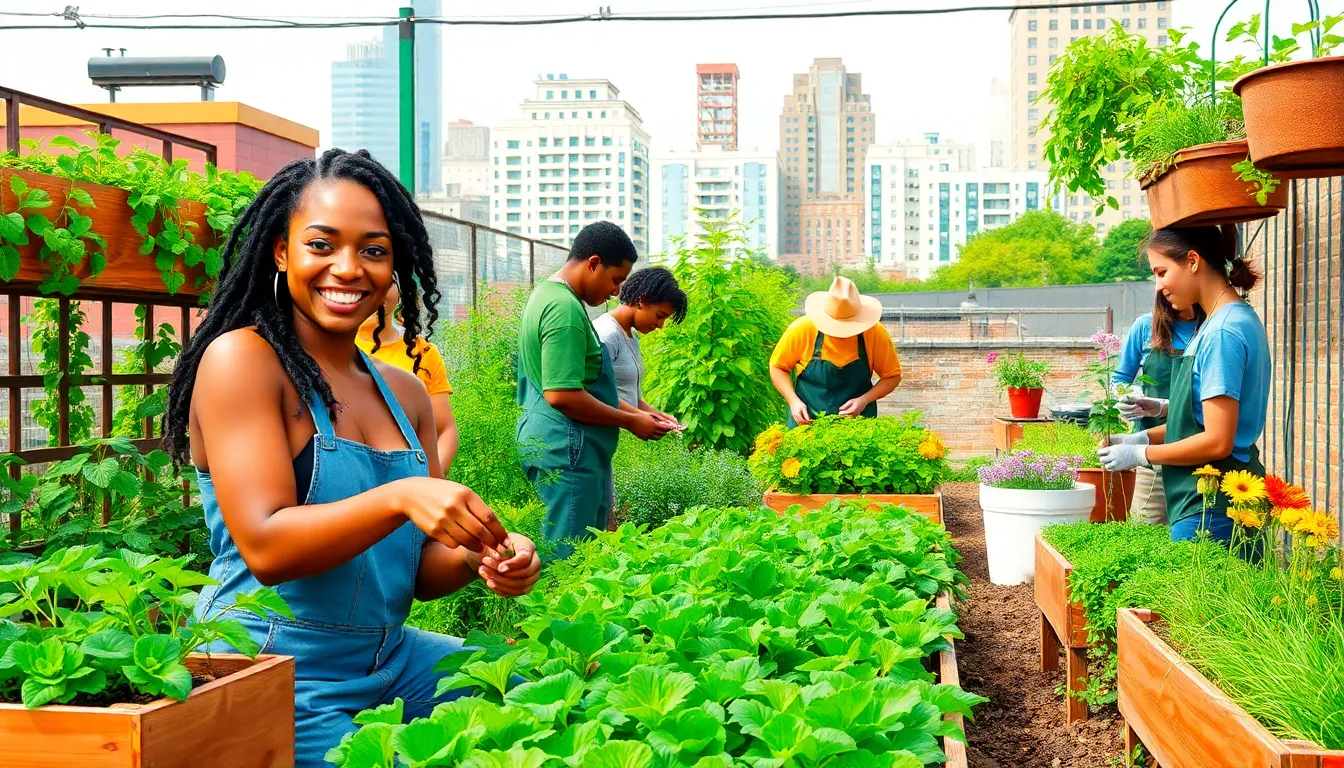In a world where concrete jungles reign supreme, urban farming is like a breath of fresh air—literally. Picture this: tomatoes growing on rooftops and lettuce sprouting in alleyways. Urban farming not only spices up the city landscape but also plays a crucial role in saving the environment. It’s like giving Mother Nature a much-needed hug while keeping the city vibrant and alive.
But wait, there’s more! Urban farms help reduce carbon footprints, improve air quality, and even promote biodiversity right in the heart of bustling metropolises. Who knew that cultivating a few herbs could lead to such a green revolution? As cities continue to expand, the benefits of urban farming become undeniable. It’s time to dig a little deeper into how these green patches are transforming urban life for the better.
How Does Urban Farming Help The Environment
Urban farming refers to the practice of cultivating, processing, and distributing food within urban areas. This approach includes various methods, such as rooftop gardens, community gardens, and vertical farms, allowing individuals and communities to grow food in limited spaces. These practices thrive in cities, where traditional agriculture often faces challenges due to space restrictions.
Environmental sustainability plays a significant role in urban farming. By harnessing available land, urban farms decrease the need for food transport, which reduces carbon emissions. Local production minimizes the distance food travels, cutting down on the associated environmental impact.
Improving biodiversity is another benefit of urban farming. These green spaces attract pollinators and other wildlife, contributing to healthier ecosystems. Urban farms often feature native plants that can withstand local conditions, enhancing urban biodiversity.
Additionally, urban farms improve air quality. Plants absorb carbon dioxide and release oxygen, creating a cleaner atmosphere. They also filter pollutants, contributing positively to urban air quality.
Community engagement is often a byproduct of urban farming. Neighborhoods come together to maintain gardens, fostering social ties and promoting a sense of belonging. This initiative helps educate residents about sustainable practices and healthy eating.
Urban farming embodies a practical solution to many challenges faced by modern cities. By integrating green spaces into urban environments, cities can create a more resilient, sustainable future for their inhabitants.
Benefits of Urban Farming

Urban farming offers several environmental advantages that contribute to sustainable city living. This practice not only enhances the urban landscape but also addresses critical environmental issues.
Reducing Carbon Footprint
Urban farming significantly decreases the carbon footprint associated with food production. Local food cultivation reduces transportation emissions by eliminating long-haul food transport. Studies show that food grown locally requires up to 90% less fossil fuel compared to food shipped from rural areas. Additionally, urban farms promote efficient land use, occupying underutilized spaces and reducing reliance on non-sustainable agricultural practices. By engaging in composting, urban farms also minimize waste sent to landfills, further lowering greenhouse gas emissions.
Promoting Biodiversity
Biodiversity thrives in urban farming settings due to the introduction of diverse plant species. Native plants attract various pollinators, which are essential for ecosystem health. Urban farms foster habitats that enable wildlife to flourish, enhancing locals’ connection to nature. Research indicates that incorporating green spaces like community gardens improves urban biodiversity compared to traditional concrete landscapes. Moreover, urban farms serve as educational hubs, teaching residents about plant species and ecosystem importance, thereby fostering environmental stewardship.
Water Conservation in Urban Farming
Urban farming significantly enhances water conservation within cities. By implementing techniques such as rainwater harvesting, urban farms capture and store rain for irrigation purposes. This practice lowers the demand on local water supplies, making it vital for sustainable agriculture in densely populated areas.
Drip irrigation systems efficiency improves water use. These systems deliver water directly to the plant roots, minimizing waste and ensuring that plants receive adequate moisture. Urban farms often employ smart technologies to monitor soil moisture levels, thereby reducing unnecessary water usage.
Native plant species play an essential role in urban farming. These plants typically require less water and adapt better to local climate conditions. By prioritizing native species, farmers conserve water while promoting biodiversity.
In addition to conserving water, urban farms contribute to less runoff. Green spaces absorb rainwater, reducing the risk of urban flooding. By using permeable surfaces in farm designs, cities can facilitate groundwater recharge, further supporting water conservation efforts.
Community engagement in urban farming fosters a culture of water mindfulness. Educational workshops on water-saving practices encourage residents to adopt similar strategies in their homes. The collective knowledge gained enhances overall water conservation within the community.
Overall, urban farming addresses pressing water sustainability issues prevalent in urban environments. It not only provides fresh produce but actively contributes to the efficient use of local water resources. By integrating these practices, urban farming becomes a cornerstone for eco-friendly cities that prioritize environmental health and community well-being.
Urban Farming and Local Food Systems
Urban farming strengthens local food systems by promoting access to fresh produce. By cultivating food within city limits, urban farms reduce the dependence on long-distance transportation. This not only cuts down carbon emissions but also enhances food security for urban residents.
Community gardens play a significant role in this process, as they provide spaces where individuals can grow their own fruits and vegetables. These gardens often serve as educational platforms that teach sustainable practices and healthy eating habits. Knowledge shared among neighbors fosters a sense of community and instills an appreciation for locally grown food.
Rooftop gardens and vertical farms also contribute to local food systems by utilizing otherwise unused spaces. These innovative approaches maximize productivity while minimizing land use. By incorporating native plants, urban farms attract local wildlife, which, in turn, supports ecological balance.
Moreover, urban farming reduces food deserts by establishing access points for fresh produce in underserved areas. Increased accessibility to nutritious food promotes healthier eating choices and reduces reliance on processed options. Research indicates that communities with urban farms experience improved public health outcomes.
Supporting local food systems through urban farming encourages economic development. Residents who engage in these initiatives often invest in local businesses. Buying seeds, tools, and supplies from nearby shops strengthens the local economy and cultivates a sustainability mindset.
Overall, urban farming creates a closed-loop system, connecting growers with consumers. This integration helps build resilience in local communities while enhancing environmental health. The emphasis on local food production not only satisfies the demand for fresh food but also contributes significantly to the overall well-being of urban environments.
Conclusion
Urban farming stands as a vital solution for enhancing environmental health in urban settings. By integrating green spaces into city landscapes it reduces carbon footprints and improves air quality. The practice fosters biodiversity through the cultivation of native plants and creates habitats for wildlife.
Moreover urban farms play a significant role in water conservation and efficient land use. They not only provide fresh produce but also strengthen local food systems, promoting food security and community well-being. As cities continue to grow urban farming will remain essential for creating sustainable and resilient urban environments.

